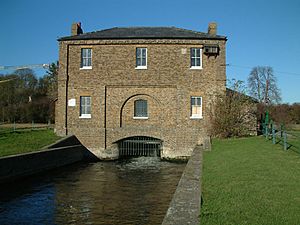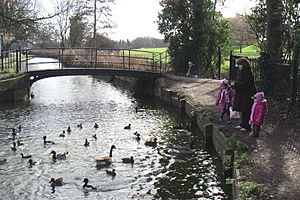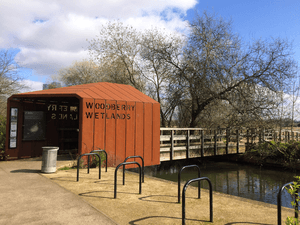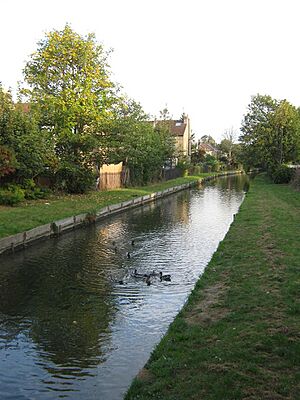New River (London) facts for kids
The New River is a special waterway built by people in England. It opened in 1613 to bring fresh drinking water to London. The water comes from the River Lea, Chadwell Springs, and other springs and wells along its path.
This river follows the natural shape of the land. But over hundreds of years, some parts have been made straighter. Even though there were times it almost closed, the New River still provides water to London today. There's even a walking path called the New River Path. It's 28 miles (45 km) long and follows the river from where it starts in Hertfordshire to its original end in Islington, London.
Contents
Where Does the New River Flow?
The New River begins between Ware and Hertford in Hertfordshire. Today, it flows about 20 miles (32 km) down to Stoke Newington. Here are some of the areas it passes through from north to south:
- Great Amwell
- Broxbourne
- Cheshunt
- Enfield
- Palmers Green
- Bowes Park
- Wood Green (near Alexandra Palace)
- Hornsey
- Harringay
- Finsbury Park
The river's first ending point was near Clerkenwell, Islington. This spot was called the New River Head. Here, the water filled a large round pond. This was next to the Sadler's Wells theatre. Water from the river was even used there to flood a big tank for special "water plays" in the early 1800s.
In 1946, the New River stopped flowing all the way to New River Head. It now ends at the East Reservoir in Stoke Newington. This reservoir is now a nature reserve called the Woodberry Wetlands. It's a very important place for wildlife.
How the New River Was Built
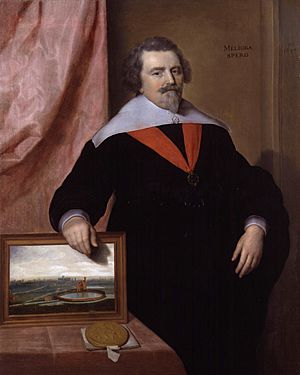
Many people think Sir Hugh Myddelton built the New River all by himself. But the idea actually came from Edmund Colthurst in 1602. He even got permission from King James I in 1604 to start the project.
Colthurst began surveying the route and digging the first 2 miles (3 km). But he ran into money problems. That's when Myddelton stepped in to finish the work between 1609 and its official opening on September 29, 1613. King James I also helped a lot. His home and land at Theobalds Park were crossed by the river. In 1612, the King took half of the shares in the project.
To make the project stronger legally and financially, the New River Company was officially started in 1619 by the King. Sir John Backhouse helped with this. The company's first reservoir was built on his land in Islington. Myddelton even gave some of his shares to Colthurst.
Building the New River was very expensive and difficult. The water had to flow using only gravity. This meant it had to follow the land's shape very carefully, dropping only about five inches per mile (8 cm/km) from Ware to London.
Myddelton also faced many problems from landowners. They worried the New River would harm their farms. They thought floods might create muddy areas that could trap their animals. Others were concerned about how it would affect roads between Hertfordshire and London. The project almost stopped when some landowners completely refused to let the river cross their land.
At one point, there was a plan for a different water project to fund a college for the King. This might have encouraged people to oppose the New River. But after that other project failed, King James strongly supported Myddelton. He agreed to pay half the costs for a 50% share. This royal backing quickly silenced the critics.
When it was first built, some long parts of the river, like around Forty Hall and in Hornsey, wound around small valleys. Other parts, including one in Harringay, were carried across valleys on wooden bridges called aqueducts. These aqueducts were lined with lead and supported by strong timbers and brick pillars. In one area, locals even called it the "boarded river." Later, in the 1700s, better canal building methods meant these wooden sections were replaced with canals made of clay banks.
Here's a fun fact: On January 9, 1622, King James was riding near Theobalds to see the ice on the New River. He accidentally fell in head first, with only his boots showing! Luckily, Sir Richard Young rescued him, and he returned to a warm bed at Theobalds.
The New River Company
The New River Company was officially formed by the King in 1619. Sir Hugh Myddelton was its first leader. The company had strict rules. It was against the law to throw rubbish or dead animals into the river. Anyone washing clothes in it or planting certain trees within five yards of it would upset the King!
The company became a big landowner in the Clerkenwell area of Islington. They built streets and squares named after people and places connected to the company. Examples include Amwell Street, River Street, Mylne Street, Chadwell Street, and Myddelton Square.
As London grew very large, the New River couldn't supply enough water for everyone. So, other companies were started to provide water to different parts of London. The New River Company's water was often found to be purer than the others. Also, because of where its water came from, it wasn't affected by a law in 1852 that banned drinking water from the tidal River Thames.
In October 1876, a scientist named Dr. Frankland compared the purity of water from different companies. He found that the New River's water was very clean compared to others. The water from companies that got their supply from the Thames often had more organic matter (impurities).
The New River Company was taken over by the Metropolitan Water Board in 1904. Then, in 1973, it became part of Thames Water. The northern part of the New River is still a very important way to supply water to London today.
The company's old main office and lab at New River Head on Rosebery Avenue are now private apartments. During the day, you can visit a viewpoint there to see the gardens. At the back of the building, you can see parts of an old medieval water pipe called the 'Chimney' or 'Devil's' Conduit. It was found in Bloomsbury in 1911 and moved here in 1927.
Changes Over Time
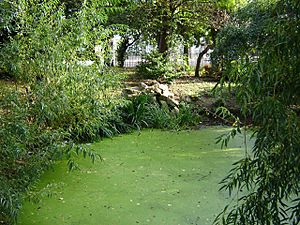
A winding part of the river that used to go through Enfield town centre has been cut off from the main flow. But it's still kept as a nice local area called the New River Loop.
Another large loop used to run around the Devonshire Hill area in north Wood Green and southern Enfield. This loop was cut off when the Wood Green tunnel was finished in 1852. The loop stayed for some decades but was completely filled in by the early 1900s. Now, homes cover where it used to be. You can still see its old path on maps from the 1800s and early 1900s.
Originally, the entire river flowed above ground. But in the late 1800s, some parts were put underground. This allowed the river's path to be made straighter. In 1946, the river stopped flowing above ground past the East Reservoir near Stoke Newington (now Woodberry Wetlands). Its water now goes directly into this reservoir. The picture on the right shows a short rebuilt part of the river in Hackney. Beyond here, the river used to follow the path of Petherton Road in Highbury.
The New River Aqueduct (at 51°40'58.6"N 0°03'16.0"W) was built in 1985. It carries the New River over the London Orbital Motorway (M25), which was being built then. The aqueduct carries the river in two parallel concrete boxes. Each box is 90 metres long, 4.25 metres wide, and 2 metres deep. This double design allowed the river to be temporarily moved during construction. It also means one side can be maintained without stopping the water flow.
Today, the New River's route provides a lovely walking path through Islington. From Clissold Park, the path follows a wide grassy area down the middle of Petherton Road to Essex Road. Here, another old part of the New River's course forms a path next to a shallow stream. This stream was rebuilt as part of a long park. At Canonbury Road, the walk continues through a fernery to Pleasant Place. An inscription in the pavement marks the New River's route here. At Islington Green, there's a statue of Sir Hugh Myddelton. The path continues along Colebrooke Row and Duncan Terrace to the Angel. Then it goes through Owen's Field to the New River Head between Amwell Street and Rosebery Avenue. White boulders mark the New River's path in some areas, like between Balls Pond Road and Essex Road, and along Colebrooke Row up to City Road.
The Dame Alice Owen's School Incident
On October 15, 1940, during World War II, about 150 people were taking shelter in the basement of Dame Alice Owen's School. The school was located on Goswell Road at the time. A large bomb hit the building directly, causing it to collapse and block the way out of the basement. The force from the bomb also broke the pipe carrying the New River, which then flooded the shelter.
A memorial to those who lost their lives in this event stands in Owen's Fields, at the northern end of Goswell Road.


